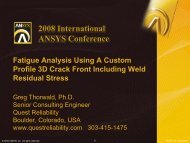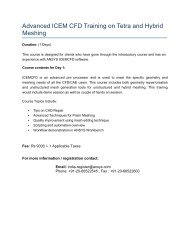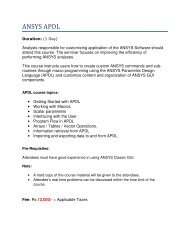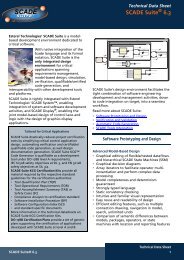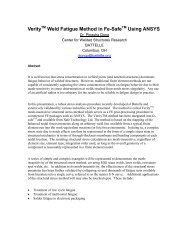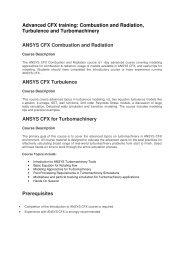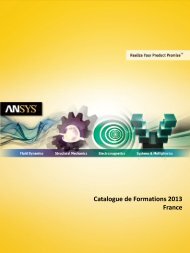Simulation - ANSYS
Simulation - ANSYS
Simulation - ANSYS
You also want an ePaper? Increase the reach of your titles
YUMPU automatically turns print PDFs into web optimized ePapers that Google loves.
The New Wave of<br />
Fluids Technology<br />
Fluid flow simulation software from <strong>ANSYS</strong><br />
provides a broad range of scalable solutions.<br />
By Paul Galpin, Director of Product Management<br />
and André Bakker, Lead Product Manager, Fluids Business Unit, <strong>ANSYS</strong>, Inc.<br />
The world of product engineering has come a<br />
long way in its quest to advance analysis from<br />
laborious hand-drawn sketches and<br />
simplistic models to virtual computercreated<br />
models initiated at the<br />
touch of a button. There has been<br />
a long evolutionary path from<br />
the inception of computational<br />
fluid dynamics (CFD) to today’s<br />
integration of this technology into<br />
<strong>Simulation</strong> Driven Product Development<br />
(SDPD) processes. Throughout its<br />
history, <strong>ANSYS</strong>, Inc. has been a technological champion<br />
for such commercial engineering simulation. The company<br />
has viewed simulation as the key to predicting how products<br />
will perform; it has enabled the rapid comparison of many<br />
different alternatives prior to making a design decision —<br />
well before customers might identify problems. <strong>ANSYS</strong> now<br />
has a fluids product line that is both broad and deep, along<br />
with a large commercial and academic user base that is<br />
reaping the benefits.<br />
This CFD evolution has required, and continues to<br />
demand, that <strong>ANSYS</strong> go beyond merely providing<br />
advanced mathematical flow solvers. <strong>ANSYS</strong> espouses a<br />
multiple physics approach to simulation in which fluid flow<br />
models integrate with other types of physics simulation<br />
technologies. The <strong>ANSYS</strong> vision is clear: to provide<br />
Contours of drug concentration in a stent and capillary wall<br />
PRODUCTS & TECHNOLOGY: FLUIDS<br />
Contours of temperature<br />
on a car body calculated<br />
in FLUENT software<br />
a system of high-fidelity<br />
multidomain analysis tools to truly<br />
enable SDPD.<br />
SDPD is centered on the highly adaptive <strong>ANSYS</strong><br />
Workbench architecture. The next major <strong>ANSYS</strong> Workbench<br />
release will provide another big step toward this vision. It will<br />
be the first release in which a number of the original Fluent<br />
CFD products will be data-integrated into the <strong>ANSYS</strong><br />
Workbench platform, and thus the tools will work together<br />
with various other applications from <strong>ANSYS</strong>.<br />
The <strong>ANSYS</strong> Workbench approach allows <strong>ANSYS</strong><br />
to provide a large variety of software choices tailored to<br />
meet individual needs while ensuring interoperability and a<br />
clear future upgrade path. This includes a very broad fluids<br />
product line with all tools falling into one of three<br />
categories: general-purpose fluid flow analysis, rapid flow<br />
modeling and industry-specific products.<br />
General-Purpose Fluids Solvers<br />
The well-known FLUENT and <strong>ANSYS</strong> CFX products are<br />
the main general-purpose CFD tools from <strong>ANSYS</strong>. These two<br />
solvers, developed independently over decades, have a lot of<br />
things in common but also some significant differences.<br />
Both are control volume–based for high accuracy and rely<br />
heavily on a pressure-based solution technique for broad<br />
applicability. They differ mainly in the way they integrate the<br />
fluid flow equations and in their equation solution strategies.<br />
www.ansys.com <strong>ANSYS</strong> Advantage • Volume II, Issue 2, 2008 17





